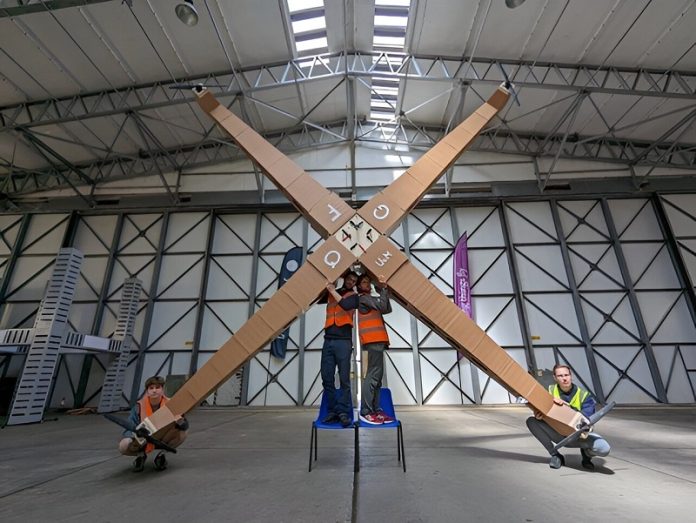
In an exciting turn of events, engineers from The University of Manchester have showcased a giant drone made from foamboard—a material similar to cardboard.
This isn’t your average toy drone.
Measuring a massive 21 feet across, this drone is the largest of its kind in the world!
What’s special about this drone?
Firstly, its size is impressive. Weighing 24.5kg, it’s just under the limit set by the Civil Aviation Authority. The drone has been named the Giant Foamboard Quadcopter (GFQ).
The GFQ has a unique design. Its four arms are hollow boxes, and you can take them off easily to move the drone around. No other drone of its size and design exists today!
Interestingly, the project began as a fun challenge. The aim? To inspire students to be creative and use environmentally-friendly materials. Most drones are made from carbon fiber, which isn’t that green. But foamboard can be recycled and even turned into compost.
Dan Koning, the main engineer behind the project, highlighted that foamboard is a great material. With clever design, you can make strong structures without adding unnecessary weight. “We’ve built the largest quadcopter drone in the world,” he proudly stated.
Why foamboard?
Well, unlike pricier materials, foamboard is cheap and green. The drone was crafted from 5mm thick sheets of foamboard. Picture this: the foamboard has a soft center and paper-like sides. Engineers then used a laser to cut the sheets and glued them together to make the 3D structure. Simple yet effective!
Josh Bixler, a famous YouTuber known for his work with remote-controlled planes, praised the project. His company provided the foamboard. He said, “You don’t need expensive materials to make awesome things. This drone is a great example of thinking creatively.”
How does the drone work?
The GFQ has electric motors and a 50-volt battery. It can even fly by itself without a pilot!
It first flew on 5 July 2023, inside a large building at the Snowdonia Aerospace Center. Many researchers from different universities were present. Everyone watched in anticipation, hoping the drone would fly without any hitches.
Kieran Wood, the person who piloted the drone, shared, “The first flight is super important. There’s so much that can go wrong. If we’ve done our job well, the drone will fly. If not, it could crash immediately.”
The university has previously made a large plane using foamboard. This inspired students to create a group that focuses on making big drones using this material. Over the past year, many students have joined in, helping to test and build parts of the GFQ.
Bill Crowther, a professor at the university, spoke about the learning experience. He said, “Foamboard is unique. It’s lightweight yet strong. But to make something fly with it, you need skills. This drone is like balancing a big weight with just pieces of paper. It’s incredible!”
What’s next?
The team isn’t stopping here. They want to make an even bigger drone! Dan Koning shared, “We’ve learned so much from the GFQ. Our next goal is to make a drone that’s 50% bigger. For that, we need to be twice as smart.”
In conclusion, the sky’s the limit for what can be achieved with some creativity, dedication, and foamboard!
Follow us on Twitter for more articles about this topic.
Source: University of Manchester.



